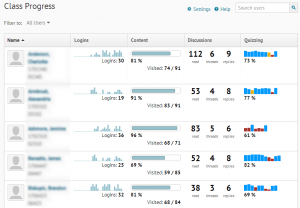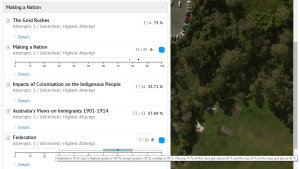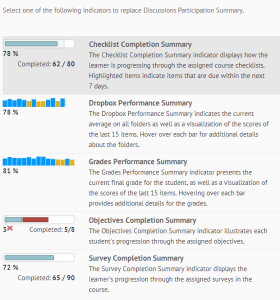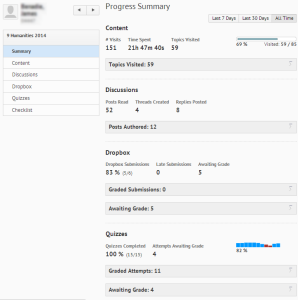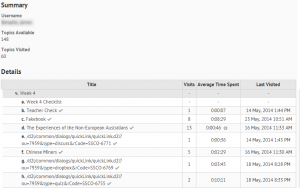A well-designed blended learning course can provide a teacher with greater insights to support his or her intuition
Intuition is a wonderful thing. Malcolm Gladwell suggests in his book Blink that an expert can draw a correct conclusion in seconds, even in the face of apparently little evidence and understanding of where the conclusion came from.
His opening example in Blink describes an apparently ancient statue purchased by a museum after many scientific tests indicated it was real.
However, experts in the field knew with a glance that it was fake.
An experienced teacher also can have significant intuitive powers. Teachers often have a “gut feel” about how a student is progressing with learning and understanding. This “feel” is often reinforced by in-class informal questions, levels of participation, quizzes, discussions, homework, and more. Results from tests and assignments provide the ultimate feedback.
However, effective blended learning courses have the ability to dramatically expand the supporting data available to a teacher. These data are more granular; more fine-tuned, detailed, and indicative of day-to-day efforts. In well designed and implemented blended learning courses, it is no longer necessary to wait for key assessment items, or time to grade a range of tasks, to gain an indication of how a student is progressing.
Blended learning courses that use a powerful learning management system to incorporate a wealth of learning resources, as well as feedback mechanisms such as quizzes and discussions, offer quantitative data to support teacher intuition. This information can allow the teacher to be even more proactive, intervening with students before key assessment occurs.
(Next page: Providing teachers with key information using graphs)
(The term “online learning environment,” or OLE, is often more appropriate with some modern systems. Some have moved well beyond being simply repositories of files accompanied by “management” tools.)
The following example uses Desire2Learn (recently rebranded as BrightSpace). Other OLEs might have similar features. Note that this is an explanation of some of the “manual” features available and does not venture into the more powerful artificial intelligence capabilities available via Desire2Learn Insights.
A concise graphical overview provides key student information. In the following example from a course (with student names blurred and photos removed for privacy), a teacher can gain rapid insights into student involvement. The following summaries are available at a glance:
- Frequency and recent dates of logins to the course;
- Amount of course content covered;
- Involvement in discussions (including posts read and replied to); and
- Results of course quizzes.
These summaries are also interactive/live. Hovering a mouse cursor over one provides more detailed information. The following image shows what happens when the cursor is hovered over one of the columns of the column graph in the Quizzes section. Some of the other summarizing images behave in a similar fashion.
This type of “dashboard” can be modified to provide different tools. For example, if a particular course uses few discussions, the Discussion summary could be replaced with another, such as a Checklist Completion Summary or another from the list in the screen shot below.
More specific individual information can be viewed by clicking on the name of an individual, as shown below.
A mouse click on any category shown will result in more detailed, specific information for that item; specific individual information is very easy to access. An example for quiz analysis is shown below. Hovering over the graph of results (in the Federation example) produces a “pop-up” summary of results from the entire group of students. (Part of the background image used in the course—an aerial image of the campus—is also visible.)
A summary of group and individual access to course materials is also available. The example following shows an individual’s access to resources within a course. This allows the teacher to gain insights into interaction with course materials, including the number of times a resource was visited, the average time spent per visit to the resource, and the date/time the resource was most recently visited.
Summary
The combination of a well-designed blended learning course, delivered by a powerful LMS or online learning environment, not only can empower student learning; it can provide a teacher with greater insights to support his or her intuition regarding student involvement in the learning process. This information is only a few mouse clicks away and takes little time to retrieve. A dashboard that provides a visual summary can make the process very easy.
However, this requires a course with sufficient material to analyze for the process to work effectively. A course should have rich and varied learning resources and a variety of activities to check student understanding. These activities might include…
- Diagnostic and formal quizzes;
- Assignment activities where files are submitted to drop boxes;
- Discussions;
- Checklists; and
- Surveys.
It takes time, thought, and effort to produce a course of this standard, but the benefits to students and educators far outweigh the costs.
Just the beginning
Once a course of this quality has been created, it opens the door to even more possibilities. Rich OLEs have capabilities that can leverage this information even further, and some of this can be automatic, saving educators more time. Automatic notifications to key staff or parents regarding students who are falling behind are possible using features such as “Intelligent Agents.”
Artificial Intelligence systems, such as Desire2Learn Insights, can be constantly working in the background to provide educators with even more information and predictive analytics to forecast student outcomes without the need to manually search for it. This allows early intervention where necessary.
Thus, building a rich blended learning course in a powerful OLE provides much more than an effective way to deliver learning resources to students; it takes education to an entirely new level of sophistication that was impossible only a decade ago.
We, as educators, should embrace these possibilities as a matter of urgency. Our students deserve it.
Peter West is Director of eLearning at Saint Stephen’s College in Australia. He has over 15 years’ experience leading K12 schools in technology enhanced education, particularly blended learning using online learning environments. He can be contacted at pwest@ssc.qld.edu.au.
- The traditional classroom works so why change it? - February 23, 2017
- Are outdated computers reverting students to a prehistoric era? - November 17, 2016
- Blended learning and the paradox of the experienced teacher - September 30, 2014


